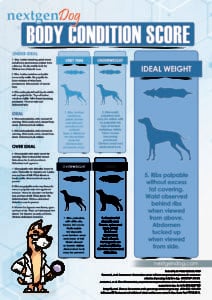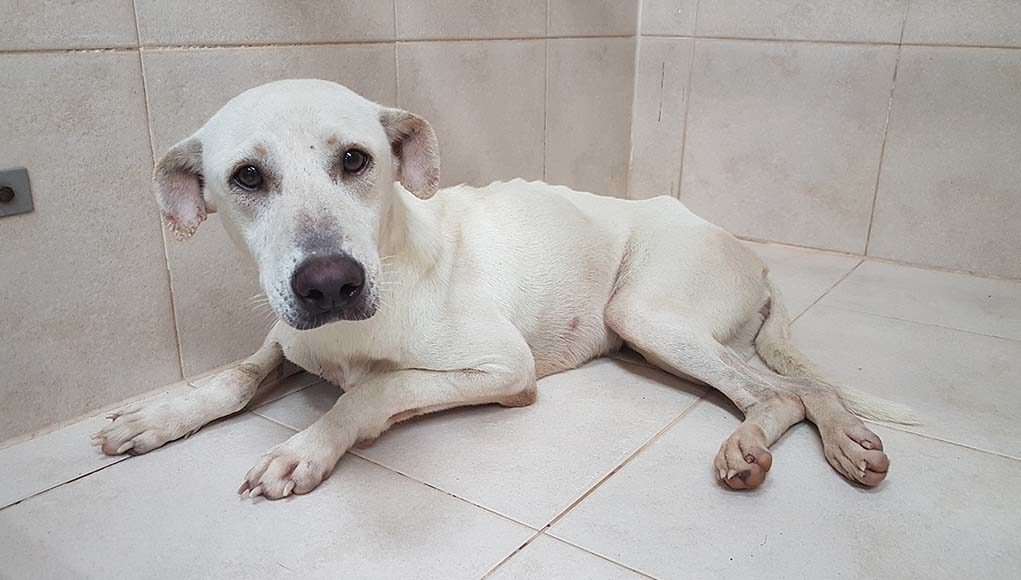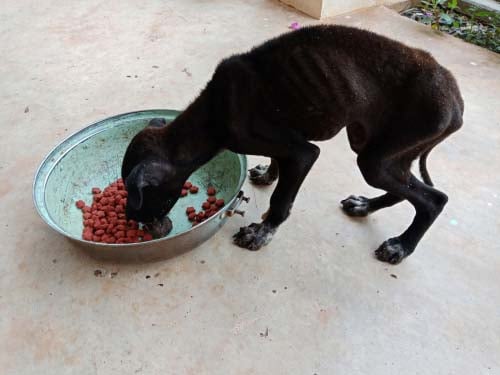Table of Contents
- How to Help a Malnourished Dog Recover
- 1. Regular Vet Visits
- 2. Appropriate and Comfortable Environment
- 3. Gradually Increased Frequency of Meals
- 4. Improved Quality of Dog Food
- 5. Gradually Increased Calorie Density
- 6. Homemade Dog Food Meals
- 7. Appropriate Exercise Routine
- 8. Tracking the Dog’s Progress
- Best Weight Gain Dog Food for Malnourished Dogs
- How to Feed an Underweight Dog
- How to Feed Underweight and Malnourished Dogs: FAQs
- How to Feed Underweight and Malnourished Dogs: Before You Go
The term malnutrition refers to dogs that have lost more than 10% of their normal body weight.
They are thin, with prominent bones, especially the hips and ribs. Malnourished dogs will often suffer from dehydration, lethargy, and skin disease.
In most cases, malnourishment in dogs is a result of a lack of food or its poor quality that can't meet the canine's nutritional requirements.
According to vets,
A malnourished dog will show several identifiable signs when he is suffering from nutrient deficiency.
Serious weight loss is the most identifiable symptom that occurs in malnourished dogs.
Dogs that are unable to get enough vitamins and minerals will often experience changes in his coat, coloring, or texture.
Sometimes, the reason is a medical condition that prevents the dog from eating.
When malnourishment occurs, it is necessary to take the dog to the vet to recommend a specific diet and help in recovery.
How to Help a Malnourished Dog Recover
 In most cases, malnourishment occurs as a result of a health issue.
In most cases, malnourishment occurs as a result of a health issue.
Once that primary problem has been solved, the dog will generally regain their original weight back.
It is crucial to start feeding an underweight dog small amounts of food a few times daily.
Providing too much food too fast to an emaciated dog may cause the development of refeeding syndrome, which is just as serious a condition.
Digestive and neurological problems can also occur if feeding too much at once.
Several crucial steps in this process, outlined below, will help the dog recover safely.
1. Regular Vet Visits
Never attempt to determine the right meal for a malnourished dog without consultation with the veterinarian.
After a thorough examination, the vet will give appropriate advice and a step-by-step plan on how to feed an underweight dog and restore them to full condition.
Also, the vet can help you monitor the progress, the dog's current weight, and your pet's overall health during these regular checkups, advising on any dietary or exercise adjustments if needed.
It is necessary to check the dog's body temperature, the state of the dog's immune system, and any possible misbehavior issues during this process.
2. Appropriate and Comfortable Environment
A malnourished dog generally needs more warmth since their underfed body will have difficulty maintaining body temperature within physiological limits.
Without the necessary amount of body fat, the dog will shiver when the outside temperature is slightly lower, leading to additional burning of calories.
Plus, a malnourished dog needs to feel safe and calm as they will be more sensitive to the environment, so it is necessary to provide a stress-free, cozy, and comfortable place for your pet to rest, play, sleep, and otherwise spend their time.
3. Gradually Increased Frequency of Meals
Providing an extra meal for the dog during the day is the most comfortable and appropriate way to help the dog gain weight.
Sometimes, the dog will refuse to eat, and syringe feeding may be necessary.
At the initial stage, the most essential thing is not to increase the amount of food per meal but to add an extra feeding time.
By preventing overeating, the dog won't have digestion or nausea issues.
4. Improved Quality of Dog Food
If feeding homemade, adding more muscle meat in meals will help the dog to put on weight in a short time.
If the dog usually eats commercial kibble, providing an extra cup of food rich in protein between regular meals will help them to add the necessary pounds.
There are certain weight-gain foods that are designed for underweight dogs.
Alternatively, many experts recommend feeding an underweight dog with high-quality puppy food, which is generally higher in protein and fat, but lower in carbs.
After determining the desired daily amount of food according to the dog's size, they should get approximately 25% of the recommended meal on the first day.
The goal is to increase the necessary daily amount of food gradually within 10 days.
5. Gradually Increased Calorie Density
On top of meal frequency and food quality, it is also helpful to choose calorie-dense dog food to help the dog consume those extra calories.
The best solution is to reduce carbs but increase proteins and fat with every meal.
Also, adding weight gain supplements that contain essential vitamins and minerals, especially phosphate, potassium, and magnesium, will support a healthy increase in the weight for the dog.
6. Homemade Dog Food Meals
Homemade meals can be chosen instead of commercial foods or fed in addition to commercial kibble.
By adding nutrient-dense foods like whole eggs to your pet's meal, the dog will get a more significant amount of protein (from egg white), vitamins (from egg yolk), and calories.
You can also add fruits and vegetables to the meal, such as apples, pumpkin, or sweet potato.
Water needs to be available to the dog at all times and constantly changed to keep it fresh and cool enough since dehydration and losing up to 15% of body water can jeopardize an underweight dog's life.
7. Appropriate Exercise Routine
Gaining weight by food intake without proper workouts can be counterproductive.
The exercise route should not be designed for burning excess calories.
On the contrary, it should be regular low-key walks and easy playtime that will improve the dog's appetite, keep the animal healthy, and prevent obesity.
Avoid forcing the dog to run or over-exercise.
The goal is to let the dog's body recover and put on lean muscle gradually.
Just as with a feeding routine, exercise should start with low-impact ones and increase gradually in its intensity.
8. Tracking the Dog’s Progress
It is essential to check the dog's overall condition daily yourself, on top of the scheduled visits to the vet.
Feeling the animal along the ribs, checking their body composition, and weighing the animal are the most proper ways to keep track of weight-gaining progress.
If the dog's weight increases over time, the actions taken are adequate.
On the other hand, if your dog's weight stagnates, you need to consult with a vet and change the diet, or increase the calories in the meal, or reconsider the dog's exercise routine.
Best Weight Gain Dog Food for Malnourished Dogs
Dog foods designed for weight gain are generally high in protein and calories and will pack additional nutrients, vitamins, and minerals (similar to weight gainers for bodybuilders).
Some of the best weight gain dog foods for underweight dogs include:
| Preview | Product | Rating | |
|---|---|---|---|

|
Eukanuba Premium Performance 30/20 Sport Adult Dry... | 170 Reviews | Check Price |

|
Bully Max High Performance Premium Dry Dog Food... | 5,865 Reviews | Check Price |

|
PURINA ONE True Instinct With A Blend Of Real... | 13,012 Reviews | Check Price |
How to Feed an Underweight Dog
Dog's Breakfast
It is the most important daily meal for underweight and malnourished dogs.
If feeding a homemade diet, this meal should include a high protein source, enriched with some carbohydrates like white rice and additional fat and vitamin sources like eggs.
Start breakfast with one cup of food and give one more in case the animal asks for more.
However, careful meal dosing is also important to prevent overfeeding and vomiting.
Dog's Lunch and Dinner
Once again, high protein is the priority for your pup's lunch and dinner.
Adding a cooked egg and rice to one cup of high-protein dog food is an excellent choice.
Carefully increase the amount if the pet remains hungry.
Dog's Treats and Snacks
Except for regular meals, the malnourished dog can have a snack mid-morning and mid-afternoon.
Among natural foods, the best choices are things like cheese, chicken, beef, and similar high-protein, high-fat foods.
Also, your dog will probably enjoy high-calorie dog treats during the day and some dry food overnight.
Probiotics and Weight Gain Supplements
As a result of the lack of food or feeding with inappropriate ingredients, malnourished dogs often suffer from gastrointestinal problems.
Therefore, adding probiotic supplements to your dog's meals will help restore regular digestive function.
Weight-gaining supplements will support the dog's body to restore overall well-being by providing essential nutrition without rapidly putting on weight by increasing the percentage of fat.
The goal is for the dog to regain muscle mass.
Supplements can help the dog regain shape by providing crucial vitamins, minerals, and omega-3 fatty acids, which are normally hard to pack into meals.
Some of the best weight gain supplements for underweight dogs include:
How to Feed Underweight and Malnourished Dogs: FAQs
How do you feed a dog that has been malnourished?
A relatively high-fat, moderately-high-protein diet should be given to dogs who are mild to moderately underweight.
The amount of carbs in these diets should be adequate but not excessive. Consider feeding foods with an 18% fat and 28–30% protein content.
What is the best food for a very underweight dog?
Your dog's diet should aim to include more wet food. Consider including vegetables in the diet that can aid in weight gain, such as potatoes or pumpkin.
Try to keep consistent intervals between feedings, and be sure to wait at least 45–60 minutes after Fido has eaten before taking him for a walk or other form of exercise.
What human food can I give my dog to gain weight?
To help Fido gain weight, you can offer him safe human food supplements such as roasted chicken without the skin, boiled eggs, canned tuna, plain low-fat yogurt, or plain tinned pumpkin.
Do not feed your dog any human foods like chocolate, raisins, grapes, garlic, or onions since they can harm them.
Can you add rice to dog food for weight gain?
Dogs can easily put on weight by eating rice. They have a ton of carbohydrates and are moderately high in calories.
If you're giving it as a supplement, your woofer should just eat a small amount because eating too many extra calories and carbohydrates can induce unhealthful weight gain.
How to Feed Underweight and Malnourished Dogs: Before You Go
Dog malnutrition can be caused by various medical problems, such as parasites, dental and mouth problems, metabolic disorders, infections, and even cancer.
You must first treat the underlying cause by taking the dog to the vet.
It's also possible that the dog was neglected by its prior owners.
Nevertheless, the main objective is to increase the dog's weight by eating enough nutrients, regardless of the dog's malnutrition underlying cause.
The next thing is to gain lean muscle by exercising.
READ NEXT:
- How Much Should You Feed Your Dog
- Recipe: Satin Balls for Dogs To Gain Weight
- How to Help Your Senior Dog Lose Weight
Disclosure: We may earn affiliate commissions at no cost to you from the links on this page. This did not affect our assessment of products. Read more here and find full disclosure here.














